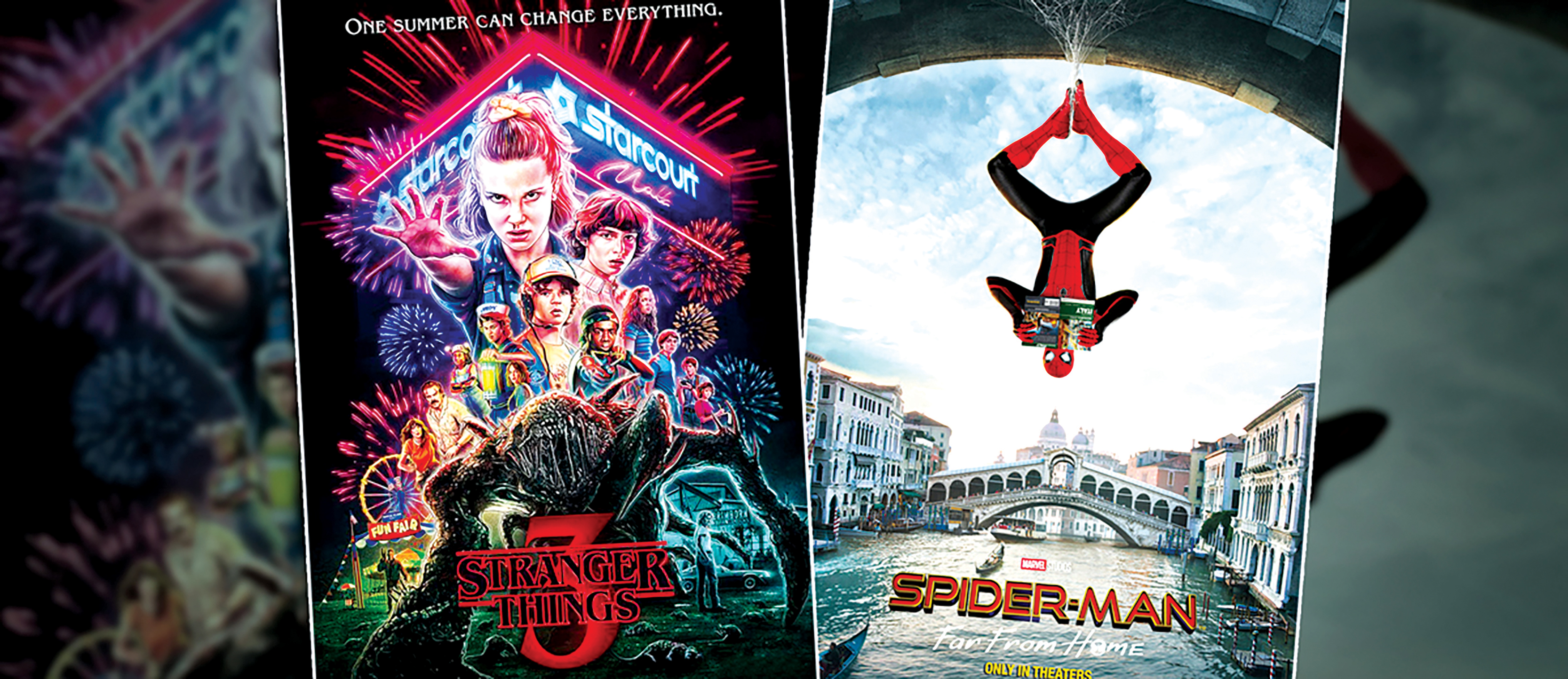If teenagers in Stranger Things 3 are dealing with the Foreign Hand, in Spider-Man: Far From Home, the teenagers are dealing with Foreign Lands
It’s my own desire
It’s my own remorse
Help me to decide
Help me make the most
Of freedom and of pleasure
Nothing ever lasts forever
Everybody wants to rule the world
In the summer of 1985, one of the Billboard chart-toppers was a song called Everybody Wants to Rule the World by a then-unknown British band Tears for Fears. The Economist called it “a jarringly cheery song about freedom, pleasure and “a lack of vision”.”
Yet it’s a song that not only endures, but has become an anthem of sorts for the ongoing geopolitical rivalry, hedonistic human behaviour and a general dystopian world view.
Stranger Things 3, which was recently released on Netflix, is a lovely and wild ride into that time. The Cold War is raging, the Mall Rats are exploding (some literally) and people are trying to come to terms with the consumerism that was unleashed in the late 1970s and early ’80s. This is a nostalgia-hit for those who grew up at the time, and a new “lack of vision” for those moving to a teenage Gen X world now.
There is also a whole new dimension of product placement and in-show branding that Netflix has opened up with its retro look and 80’s feel.
In Season 3, Mike, Lucas, Will and Dustin get an education in being teenagers. They learn about the world of love and parental authority. Mike and Eleven/El are a brand-new couple, while Lucas and Max are like an old married couple—together but bickering and learning to give each other space. In fact, some of the best moments in the show are when Max takes charge of the psychokinetic El and teaches her that not having a boyfriend can be as exciting and fulfilling as having one, perhaps more so. “Who needs stupid boys,” she says, compensating El with a new wardrobe and Wonder Woman comics in their new-found sisterhood.
Will is the talisman this season. His only hope is to keep his childhood alive cocooned in roleplay and Dungeons and Dragons. Yet having been in the evil’s grip in Season 2, Will has instinctive alertness to the Mind Flayer’s presence, and he helps the team work out its machinations. This season the threat is all too real—not just Sci-Fi villains and twinkling fairy lights.
Meanwhile, Dustin has just come back from Science camp where he’s met an unbelievable and beautiful girl, who is also a nerd, something nobody else believes is possible. Dustin is, therefore, isolated and leads the parallel story of a Ham radio indicating the presence of the Enemy on American soil. It’s a convoluted track with predictable Cold Warfare, but the innocence, cuteness and droll behaviour of not just the children but also Steve and Robyn (their “adult” supervisors) make the proceedings fun and hilarious. It’s all spoofy nostalgia and innocent fun until lives are lost and the world Down Under catches up with them.
The best thing about this show is how the children are involved and invested in saving their friends, home or country (S3), and do so with ingenuity and enterprise. For those of us growing up in the ’80s and ‘90s, we spent a lot of time being “bored” with not much access to entertainment, so we were creative with our time. Jugaad was our leitmotif, and we see that in Stranger Things also. The kids ride their bikes into a world of adventure, science labs, eerie forests and hangouts and a Ham Radio—this season allows them access to an international conspiracy.
The ‘80s were also a time when communication was restricted, and Google did not exist. The scenes of the children and adults working out the Science of the Upside Down and the Mind Flayer are interesting. Most of all, the children are not scared to take initiative. They don’t wait for adults to figure things out. They move on without much thought of consequences. It was a time to be brave, and it was the time for the individual to contribute. Perhaps, it was also a time that seems quaint and foolish now in hindsight.
If the teenagers in Stranger Things 3 are dealing with the Foreign Hand, in Spider-Man: Far From Home, the teenagers are dealing with Foreign Lands.
In 2019, Tom Holland, the British teenage Spiderman, is recovering from an Avengers overload and all he wants to do this summer is take a holiday with his classmates in Europe. An old-style 1980’s holiday, with friends, no distractions, no adult supervision and the chance to tell MJ about his love for her. It’s all quaint with teenage rebellion. Nick Fury is ghosted, and Aunt May asked not to mention the Peter Tingle and even forget the Spiderman costume, until…it’s too late.
Spider-Man: Far From Home is billed as the last film in Phase 3 of the Marvel Cinematic Universe, and the precursor to Phase 4, where Tony Stark aka Iron Man has finally been laid to rest and a capable successor is yet to be crowned. Can that successor be Spiderman? That is the question this film raises.
If the teenagers in the 80s were dealing in innocence and bravado, in 2019 it seems teenagers are dealing with Fakes—in the news, in the perception of reality, in their ability to communicate their emotions and in their relationships with the adult world. There is no universal truth as we know it. All of this is on display in Spider-Man: Far From Home.
When Tony Stark left behind E.D.I.T.H as his legacy for Spiderman, little did he know perhaps, that his protégé only wanted to be a “friendly neighbourhood Spiderman” and not an Avenger-level Superhero. Or maybe Stark was a canny-enough genius to know that the first big fight that a fledgeling superhero must fight and win is that of perception. Every Superhero film has the same formula: a nemesis who plays the public to frame and shame the hero, until the hero turns things around and exposes the villain.
This time the villain is literally and metaphorically a creature with the head of a fishbowl, a champion in the art of illusion, Mysterio. Mysterio or Quentin Beck was introduced as a villain as far back as The Amazing Spiderman (June 1964) and has got an update in Far From Home.
Jake Gyllenhaal as Mysterio is attention-grabbing and the parallels with the world today seem striking, but the villainy of the character itself is ordinary. Technology enables Mysterio to control the illusion of a grand battle with the Elementals but then ultimately it is good old emotion that allows him to con Spiderman.
As Tears for Fears sang way back in 1985:
“Say that you’ll never, never, never,
need it
One headline, why believe it?
Everybody wants to rule the world.”
What is Real and what is Fake are the true measure of Good versus Evil in 2019, and the post-credit reveal leaves a major “what the f*#k” pending to be answered in the next film.
Although engaging, Spiderman: Far From Home falls short of being little more than a glossy yet simple family entertainer. There is no real contemporary teenage issue raised. Even the potential of a more complicated villain or a Universe/the Multiverse premise is not fully explored. It is just casually touched upon as an explanation to Mysterio’s backstory.
Critic Anupama Chopra even calls it an Imtiaz Ali style “teen comedy”.
In a popular listicle, Parentology.com mentions the problems teenagers face in 2019. These include a lack of acceptance from parents, stress from school (both peers and helicopter parents), depression and anxiety linked to social media, self-harm, desensitisation, bullying, dangerous sexual behaviour, disrespect for authority, trust issues and a lack of motivation and confidence to move forward.
This is where Spider-Man: Into the Spider-Verse scores its Oscar win.
Perhaps, the next iteration of Spiderman will also open up the Multiverse for an Avenger-level battle led by Spiderman. It could then be called Spider-Man: The Iconic Teen?
Meanwhile, just being a Teenager in 2019 seems to be the toughest thing in the world. Ask Spidey, as he rushes to a date, he is warned by his girlfriend not to take a selfie while swinging!
Nobody is safe out there, not even our Superheroes.
You have a choice to disbelieve all of this too. As Mysterio iterates again and again: “People believe anything these days.”
‘Cos nothing is real, and everyone wants to rule the world!
www.newslaundry.com





